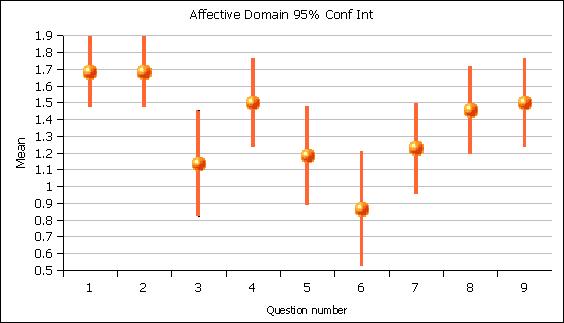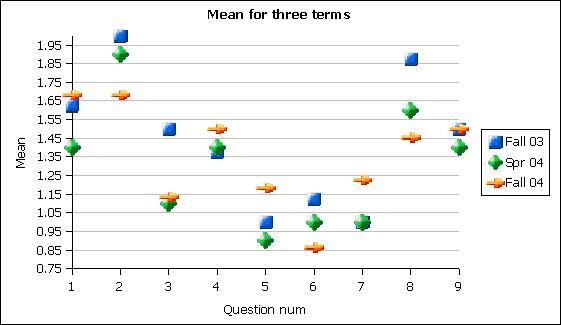
The Exercise Sport Science program has one affective domain student learning outcome:
Students will value physical activity and its contribution to a healthful lifestyle.
The ESS 101j Joggling course has an affective domain student learning outcome identical to the above:
Students will value physical activity and its contribution to a healthful lifestyle.
The course also has a second student learning outcome currently listed as a course intention:
Students will have an opportunity to experience the joys of aerobic exercise: the feelings of strength, energy, and stress release.
The issue of including and evaluating affective domain outcomes was covered in a document written 13 November 2002, http://www.comfsm.fm/~dleeling/department/slorevolution_vi.html.
In December 2003 a survey was given to the joggling students. The students answered nine questions:
The students were offered the following choices: strongly disagree, disagree, maybe, agree, strongly agree. The five options were assigned the following values:
Strongly disagree: -2
Disagree: -1
Maybe: 0
Agree: 1
Strongly agree: 2
The results of the fall 2003 survey were reported on in a document at: http://www.comfsm.fm/~dleeling/department/slorevolutionviii.html
On 22 April 2004 the same survey was administered to the spring term joggling class. The results paralleled the results of last fall and are available at: http://www.comfsm.fm/~dleeling/department/k41affectivedomainsurvey.html.
The same survey was administered on 02 December 2004. There was no statistical disagreement with any of the statements. The 95% confidence intervals were calculated for each question: any question that crosses y = 0 would be deemed statistically indistinguishable from "maybe." The sample size is 22 students. The chart below has the question number on the horizontal or x-axis. The ball is at the mean or average score for the 22 students, the orange bar is the extent of the 95% confidence interval for the mean.

The following chart shows the means for each of three surveys. The overall pattern of prior terms can be seen to have been repeated: across the terms some questions see consistent strong agreement while other questions remain consistently lower.

Question one, "I enjoyed participating in the physical activities of this class," rose strongly against spring 2004 performance and tied question two for the strongest level of agreement. With of mean of 1.68, this is the highest agreement attained on question one over the past three terms.
As seen in the prior terms, question two generated the strongest agreement - although this term two tied with one for the highest level of agreement. Two asked, "Physical fitness is important to my present and future lifestyle." The mean, however, fell against prior term performance. The students conceive that physical fitness is important, but possibly less so than in prior terms.
Question three, "Exercise and physical fitness is an important part of my college experience," remained near the spring 2004 value at 1.14. Students agree, but not strongly.
Question four, "I have enjoyed participating in Joggling class," saw good agreement.
On question five, "I feel I am more fit as a result of this class," three students responded "maybe," the rest answered in agreement or strong agreement.
Question six, "Because of the skills I have gained in this class, I would like to continue running in the future," had the lowest mean of the questions. This question saw a relatively low mean in spring 2004 and fall 2003. Five students said "maybe," one disagreed, while the rest agreed or strongly agreed. The survey is a self-assessment and the students are, by this point in the term, well aware of the answer their instructor would likely desire. Anecdotal evidence suggests no former student continued to run, the low mean on this question indicates this pattern will continue.
Question seven, "This class has improved my attitude towards the sport of running.," had a relatively low mean. The mean, however, is still at a level of agreement.
Question eight, "I had fun in this class," rated in the middle of the pack of means. The value, however, was down from prior terms. The class was not as much fun as in prior terms. The students were split fairly evenly between agree and strongly agree, with a single "maybe." My sense is that more than one did not find the course enjoyable, but are hesitant to say so for social and cultural reasons.
Number nine directly asked whether the student learning outcome that was couched as a course intention was accomplished. "I feel I have experienced the joy of aerobic exercise: the feelings of strength, energy, and stress release." The mean was 1.5 this fall, 1.4 spring 2004 and 1.5 fall 2003. The 1.5 mean this term with a confidence interval that is wholly above 1.2 indicates continued moderately strong agreement. Twelve students strongly agreed with this statement, nine agreed, and one responded, "maybe." This outcome can be measured and can be reported upon, even though it was this very outcome that generated the most flak in the fall of 2002 when it was first introduced. Student learning outcomes include that which we want a student to do, know, or value. The later may be the hardest to work with, but values can be measured and reported.
Two additional questions looked towards the future. One asked whether future walking classes should walk only around the gym, walk on the road, or mix both gym laps with road walking. Eighteen of twenty-two favored the third option, three the second, only one student felt the walkers should only walk around the gym.
The final question asked whether running should be offered as a course. Nineteen responded yes, three left the question blank. Given the likely hesitancy to answer no, the three blanks should probably be taken as negative responses. Four students commented on this question The comments were:
To read any of the reports done fall 2002 on student learning outcomes, please turn to:
http://www.comfsm.fm/~dleeling/department/dnsm.html#mslos